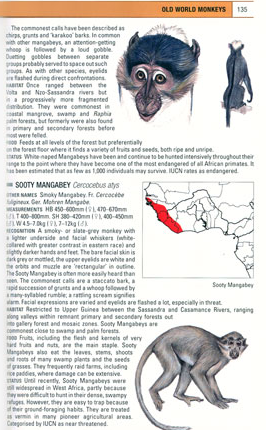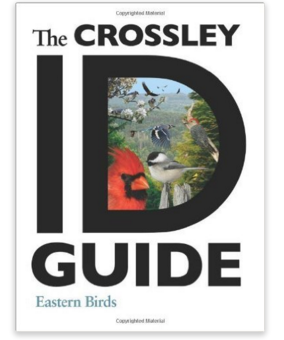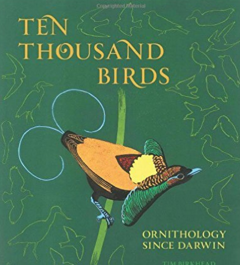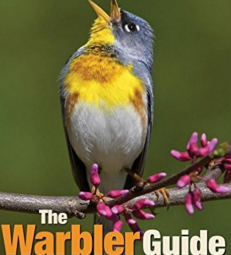Here we look mainly at bird books, but I wanted to also mention a couple of other items on non-birds. I've mixed in some new books along with a few other books that have come out over the last couple of years, but that are still very current, very amazing books, and since they have been out for a while, may in some cases be picked up used or otherwise less expensively.
 Let's start with the least-bird like book, one that will be a must have for anyone traveling to or studying Africa. This is The Kingdon Field Guide to African Mammals: Second edition
Let's start with the least-bird like book, one that will be a must have for anyone traveling to or studying Africa. This is The Kingdon Field Guide to African Mammals: Second edition. This is a newly produced edition of this now classic work, which pretty much replaces most of the other guides. However, be warned, the book is a bit big and thick. If you are going on safari, consider also getting something smaller and more pocket size such as Pocket Guide version of Kingdon
or the more classic Dorst and Dandelot A Field Guide to the Larger Mammals of Africa
.
Kingdon is a naturalist and an amazing artist. The guide is detailed and has more species than any other guide. The maps are excellent and detailed. The drawings are both lifelike and designed to highlight key features. The text includes a lot of background on evolution and physical variation. This is just a great book. For African mammals, this is, these days, the guide.
A book with all the African mammals is fairly large. There are just enough carnivores in the world (excluding seals and their kin) to put them all into one book. Carnivores of the World (Princeton Field Guides) is just plain a lot of fun. It is a bit silly, perhaps, to have a field guide to all the carnivores, because where exactly are you going to travel and see all the carnivores? But it is amazing to see them all in one place, well organized, similarly treated.
 Flight has evolved many times, and only some of those evolutionary events are visible in living form today. We have to assume that flight is one of the most useful adaptations, and at the same time, difficult to emerge. David Alexander's On the Wing: Insects, Pterosaurs, Birds, Bats and the Evolution of Animal Flight
Flight has evolved many times, and only some of those evolutionary events are visible in living form today. We have to assume that flight is one of the most useful adaptations, and at the same time, difficult to emerge. David Alexander's On the Wing: Insects, Pterosaurs, Birds, Bats and the Evolution of Animal Flight is a careful and intriguing look at the evolution of fully powered flight in the four major groups that achieved this ability.
While birds have received the majority of attention from flight researchers, Alexander pays equal attention to all four groups of flyers-something that no other book on the subject has done before now. In a streamlined and captivating way, David Alexander demonstrates the links between the tiny 2-mm thrip and the enormous albatross with the 12 feet wingspan used to cross oceans. The book delves into the fossil record of flyers enough to satisfy the budding paleontologist, while also pleasing ornithologists and entomologists alike with its treatment of animal behavior, flapping mechanisms, and wing-origin theory. Alexander uses relatable examples to draw in readers even without a natural interest in birds, bees, and bats. He takes something that is so off-limits and unfamiliar to humans-the act of flying-and puts it in the context of experiences that many readers can relate to. Alexander guides readers through the anomalies of the flying world: hovering hummingbirds, unexpected gliders (squirrels, for instance), and the flyers that went extinct (pterosaurs). Alexander also delves into wing-origin theory and explores whether birds entered the skies from the trees down (as gliders) or from the ground up (as runners) and uses the latest fossil evidence to present readers with an answer.
The following several books are bird books that have been available for a range of time (mostly not too new, at least one quite old) but that are either really nice books, or invaluable references.
Bird Guides
The Warbler Guide by Tom Stephenson and Scott Whittle is the definitive guide to warblers. It includes all the North American species, with excellent visuals and a lot of information about the birds and their songs, including sonograms designed to actually relate the visual image to the sound itself, as an aid in identification. Because, let's face it, you are going to hear a lot more warblers than you are going to see. Which is why they are called "warblers" instead of "colorful little birds." Perhaps unique among bird guides, this book has quizzes to make sure you are keeping up. There are piles of other information about warbler watching
All of the Crossley ID guides are fantastic. These are not pocket books, but they are car books. You put them in your car when you are out looking for birds. These guides are unique in the way the birds are depicted, giving you views of the birds as they actually look in the wild, including really far away or hiding in the bushes, or all the other things birds do. Everyone needs to have a couple of these.
 The Crossley ID Guide: Eastern Birds (The Crossley ID Guides)
The Crossley ID Guide: Eastern Birds (The Crossley ID Guides) mirrors the typical Peterson type guide in its coverage. This is to be supplemented by the very valuable The Crossley ID Guide: Raptors
for the hawks and such. There is also a The Crossley ID Guide: Britain and Ireland
.
Some of the Crossley guides come in an alternative binding format
Bird Books About Birds (evolution, history, biology)
There is a handful of books that I tend to go back to again and again to learn things about bird biology, the history of bird research, or other things beyond field identification.
The first one I would recommend is The Birder's Handbook: A Field Guide to the Natural History of North American Birds by Paul Elrich, David Dobkin, and Darryl Wheye.
 This is an older book but little of the information is out of date. This is where you look up some bird you've been watching or wondering about and find out the real tale behind the tail. Since it is an older book you can obtain it for just a few dollars.
This is an older book but little of the information is out of date. This is where you look up some bird you've been watching or wondering about and find out the real tale behind the tail. Since it is an older book you can obtain it for just a few dollars.
Ten Thousand Birds: Ornithology since Darwin by Tim Birkhead, Jo Wimpenny, and Bob Montgomerie is an authoritative, rich, well written, big, giant, tome that reviews the history of research, and the researchers, over many decades of bird study. Bird biology is a major part of organismic (meaning, not inside the cell or body, but outside) biology. So, in a sense, this book is a history of our understanding of how animals in general work. Again, because it has been out for a few years, you may find a good price on a used edition.
The next six books cover conservation, the intersection of birds and art, or expose detailed information about a single group of birds. They are all coffee-table level quality but rich in information and in some cases just plain inspiring. They are all current, but not right out of the publishing houses, so they can be obtained at a reasonable price, in most cases.
The World's Rarest Birds (WILDGuides). There are something over 10,000 species of birds (thus the name of the famous blog). Of these, just under 600 are in very very serious trouble, some to the extent that we are not sure if they exist, others are so rare that we know they exist but there are no good photographs of them, others are merely very likely to go extinct. There are patterns to this rarity, having to do with what threatens birds on one hand and what makes certain birds vulnerable on the other, but the range of birds that are threatened, in terms of size, shape, kind of bird, habitat, etc. represents birds pretty generally. It is not just obscure frog-like rainforest birds of Borneo that are threatened. Chance are you live in a zone where there are bird species that have gone extinct over the last century, or are about to go extinct over coming decades, including birds that you will never see unless you are very very lucky.
Rare Birds of North America is the only extensive treatment I’ve see of the so called “vagrant birds” in the US and Canada. Most, or at least many, traditional bird books have a section in the back for rare birds, occasionals or accidentals, which one might see now and then. But when you think about it, how can five or even a dozen species in a bird book really do justice to the problem of spotting birds that are normally not supposed to be spotted?
Penguins: The Ultimate Guide is a beautiful coffee table style book full of information. All of the world’s species are covered (amazingly there are only 18 of them) and there are more than 400 excellent photos. The book covers penguin science (science about them, not by them). There is also quite a bit about their conservation.
The layout of the book is interesting. The last section of the book, by Julie Cornthwaite includes portraits of each species, and a compendium of interesting facts such as which is the fastest penguin, strange things about their bills, their odd moulting behavior, interesting color variants, how they “fly”, interesting mating facts, and what threatens them. Then there is a table organized taxonomically giving their status, population estimates, ranges, and main threats. Following this is a two page bird-guide type spread on each species, with a range map, photos, descriptions, information about their voice, breeding behavior, feeding behavior, etc. That is what you would expect in a book about penguins.
But the first, and largest, part(s) of the book provides its uniqueness. The first section, by Dui De Roy, covers penguins generally, or specific exemplar species or groups of species, to provide an overview of what penguin-ness is all about. The second section, edited by Mark Jones, consists of 17 essays by various experts on specific topics, such as how penguins store food, how they are tracked at sea, and penguin-human interaction. I would like to have seen more about penguin evolution (which is interesting) but the sparsity of coverage of that topic does not detract from the book’s overall quality.
Five families of birds make up the group that could be referred to as the Cotingas and Manakins, which in turn include species with such colorful names as “Pale-bellied Tyrant-Manakin,” “Bare-necked Fruitcrow,” “Peruvian Plantcutter,” and “White-browed Purpletuft.” And certainly, you’ve heard of the Andean Cock-of-theRock. These birds and their relatives are THE famous colorful amazing birds of the Neotropics, the birds people who go to the Jungles of Central and South America go to see. “… the song of the Xcreaming Piha,… the loudest bird on Earth, is used by moviemakers to epitomize jungle soudns the world over, no just in its native South America,” we are told by the authors of Cotingas and Manakins, an amazing new book that you need to either add to your collection right now or give to your favorite birder.
How are birds related to dinosaurs, crocodiles, and pterosaurs? Where do birds live, and not live? How many bird species are there, and how many actual birds, and how does this vary across the glob? What about endemics?; Where ate the most local species found? Mike Unwin’s The Atlas of Birds: Diversity, Behavior, and Conservation covers this and more in a richly illustrated detailed global survey of Aves.
The image at the top of the post is by Analiese Miller. Ana is a fantastic bird photographer, and you can see some of her work either by visiting my house and looking at my wall, or by visiting this web site.
- Log in to post comments

For The Warbler Guide you can download all the songs/calls that are in the book at a reasonable price (info on where to do that will be in the book).They also have the book as an e-book (I have both).
Far more exciting, in my opinion, is The Warbler Guide app. It has the various song types at your fingertips, complete with the spectrogram (when interpreting recordings this is the feature I use most often). You can rotate their 3D birds to any angle, which is useful when you catch a glimpse of a bird from less than an ideal angle (haven't had to use for ID myself as I either know the bird anyway or the bird is so generic there is no way any angle will help me---still, I like playing with it).
They have all the regular views as well (side, face, 45 degrees, underside, undertail). Under each bird there are tabs with Comparison Species, Overview, Photos, Age/Sexing, and Maps, as well as the glyphs that they use in the book for range, where it feeds, etc. They have managed to take all the best features of the book and brought it into the app.
This app, if I may keep raving, sets the standard for other bird apps to follow. I'm sure Sibley has taken note, and I imagine future bird apps will incorporate these features.
Incidentally, when I emailed the authors to ask for info (and tell them how much I liked their book) they told me they have plans for other books in the series (shorebirds, sparrows, maybe a full field guide at some point).
So, yes, this would be a great gift for people interested in birds. I use it on a professional basis, but it is accessible to most people interested in birds.